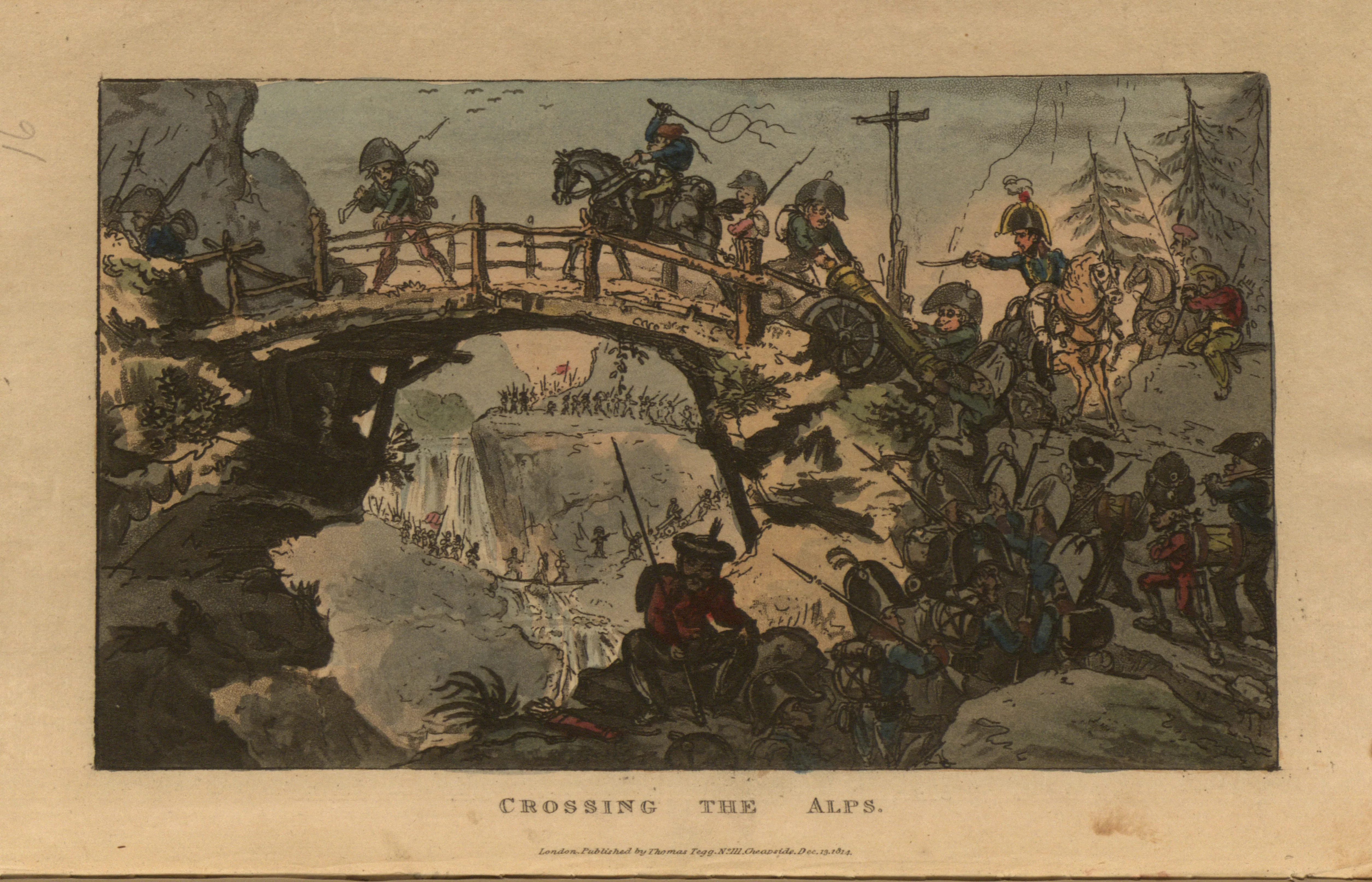Exhibit
Creation Date
13 December 1814
Height
11 cm
Width
19 cm
Medium
Genre
Description
This image primarily depicts Napoleon's attempt to lead the bedraggled French forces across the Italian Alps. More significantly, the image criticizes Napoleon's lust for wealth and power by including the decontextualized figure of the Asian man, who serves as a symbol of the common perception of Asia as a source of capital.
In this image, the French army attempts to cross the Alps during the Napoleonic Wars. Front and center in the image is an Asian man sitting on a boulder. Leading away from him are the caravans of French soldiers. Each man is carrying a pack on his back, along with weapons. The trail leads to a bridge, where Napoleon seemingly advises the other men as to how to get the cannons across the bridge, which extends over a river. Of the some thirty men depicted, only three are on horseback. This includes the men who are so far in the background they are nearly stick figures. The men are high in the mountains, for the river is a long fall. The grass and few pine trees included are green.
An Asian man sits at the forefront of the image, an incongruous (or erroneous) element in the European landscape. Because Cruikshank was an educated man who lived through the Napoleonic Wars, it is likely this "error" is intentional, connotative of imperialism. A major motivation behind Napoleon’s desire for conquest was an increase in capital. At the time, Asia was characterized as a source of tea, gold, and silk, items which were considered luxury goods due to their limited quantity. Consequently, the presence of the Asian figure in the image implicitly depicts Napoleon as a seeker of wealth and power.
By this point (May-June 1800), the troops in Napoleon’s army were malnourished, improperly equipped, and untrained. Many, for instance, had to be taught how to load, wield, and fire their muskets. Instead of asking for aid, Bonaparte insisted in his letters to Paris consuls that the men were in fine form. In addition, there was a serious lack of transportation. The weather conditions were so formidable that Bonaparte and his army were forced to resort to creative means; for instance, in order to transport heavy cannons, the men hollowed out pine trees and attached harnesses to them to create sledges (R. Asprey, Reign 434).
A political caricature is intended to depict newsworthy events as they are idiosyncratically perceived by the creator; this implicit commentary often purported to respond to the silence or obfuscation perpetrated by the government. In essence, this image was anti-Napoleon propaganda. Although still a caricature, it is far less grotesque than the other images in William Combe's The Life of Napoleon: A Hudibrastic Poem in Fifteen Cantos (1815): the people are less physically distorted, and there is more historical accuracy.
This caricature relies (albeit subtly) on the Romantic notion of mountains as a source of the sublime: “The idea of the ‘sublime’ was associated with anything that induced feelings of awe, terror, and wonder, such as the dramatic, soaring mountain scenery that is found in the Alps” (N. King, The Romantics 61). In the print, four sets of mountains fade gradually into the distance.
On the other hand, the satirical function of the image is clear. Mountains were considered a source of the sublime on account of their tendency to induce elevated feelings; however, Napoleon and his troops—stumbling through the Alps with their industrial items and battle gear—are not in a position to either experience or induce such feelings. This juxtaposition works to exaggerate the contradiction inherent in the image.
Locations Description
The passage through the Alps taken by Napoleon and his troops was on the border of Italy. While some of his men were fighting in Egypt, his troops in Italy were nearly forced out of the country.
Publisher
Thomas Tegg
Collection
Accession Number
CA 8938
Additional Information
Bibliography
Asprey, Robert. The Reign of Napoleon Bonaparte. New York: Basic Books, 2001.
Combe, William. The Life of Napoleon: A Hudibrastic Poem in Fifteen Cantos. London: T. Tegg III, 1815.
King, Neil. The Romantics: English literature in its historical, cultural, and social contexts. New York: Facts on File, Inc., 2003.

